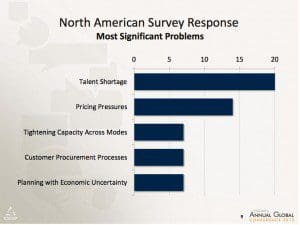Earlier this month, I was speaking with a supply chain executive about his relationship with a 3PL, and although the relationship is going well so far, he raised a concern. “The people who lead the company are very knowledgeable and good at what they do,” he said, “but once you go below that top management layer, I’m less confident about the skills and capabilities of their lower-level people.”
His comment underscored a growing concern across the industry, affecting both 3PLs and shippers: a shortage of supply chain and logistics talent.
Talent shortage was the most significant problem cited by 3PL CEOs in the “2012 3PL Provider CEO Perspective Survey” conducted by Dr. Robert Lieb at Northeastern University. The slide below is from the presentation he gave at the CSCMP Annual Conference a couple of weeks ago, along with Dr. Kristin Lieb from Emerson College and Joseph Gallick from Penske Logistics.

Of course, finding talent is only half the battle; keeping them is the other.
Back in June, I participated in a think tank session on talent management with a group of supply chain executives. The session was led by Jim Rice from MIT who has conducted research in this area. Here are some of the ideas and comments that came up in the discussion:
- The biggest challenge with talent is mobility. Those with the most experience/skills are less willing to relocate, while those most willing to move are less experienced/skilled. This is linked to where a person is in their life/work cycle (young and single vs. mid-career with house and family vs. late career with grown children). The economy and housing market are also playing a role.
- There is also a “Free Agent” mentality in the market, particularly with young professionals—i.e., a willingness to leave current employer for more money and/or a bigger career opportunity. Supply chain executives generally expect their most talented employees to leave at some point.
- Executives shared examples of rotation programs where employees rotate through different supply chain roles over the course of 1-3 years. A program at Lenovo, for example, has led to a significant improvement in talent retention rate.
- Does your supply chain organization have a dedicated HR person/staff? The answer often depends on where supply chain fits (and its importance) within the organization.
- There seems to be a wide disparity in how well universities are preparing students for supply chain careers. Some participants referenced survey results published by Supply Chain Management Review, and Jim Rice mentioned the Supply Chain Talent Academic Initiative (SCTAI), a Special Interest Group hosted by the Supply Chain Council (however, since the website was last updated in November 2010, this group doesn’t seem to be very active).
- When it comes to professional development, there needs to be a balance between formal programs, such as university courses, and informal ones, such as having a mentor (preferably from outside your department), visiting other companies to see how they manage their operations, and taking a “see one, do one, teach one” approach.
So, what’s the solution to this talent shortage problem?
I’ve discussed some of my ideas in previous postings — see, for example, “Putting Leadership Development and Learning Back on Your Calendar…and Budget!” and “A Farm System for Supply Chain and Logistics: Preparing the Next Generation of Leaders” — but let me boil them down to three recommendations:
- Make high school students and teachers aware of the role that supply chain and logistics plays in our daily lives. Many of today’s supply chain professionals, if not most, did not even know this field existed until many years after graduating from college. The earlier you can raise interest and awareness about supply chain and logistics, the more students and young professionals you’ll motivate to pursue this career path.
- Develop an ROI model for talent development and establish metrics. This is not an easy task, which is why talent development and education are an easy target for cost reductions. One approach is to link the ROI of your talent development and education investments with the ROI of your key initiatives. In other words, if your investments in learning and leadership development can help you make smarter decisions faster related to your key initiatives, then the value is more tangible and measurable.
- Think beyond four year universities and traditional education programs. They are still important, but they are not the only path to learning and talent development. Community colleges and vocational schools also need to play a bigger role. And thanks to new technologies and services, engaging in peer-to-peer learning is now easier than ever.
There’s no quick and easy solution to the talent shortage problem, but the sooner all stakeholders take some action — educators, employers, students, and current professionals — the less of a problem this will be in the future.
Do you agree that talent shortage is the most significant problem facing 3PLs and shippers? What recommendations do you propose? Post a comment and share your viewpoint!
















